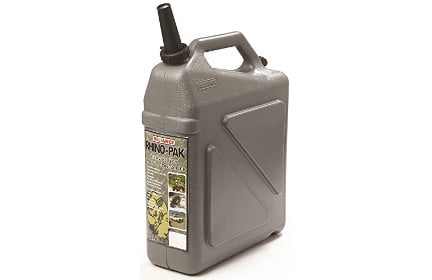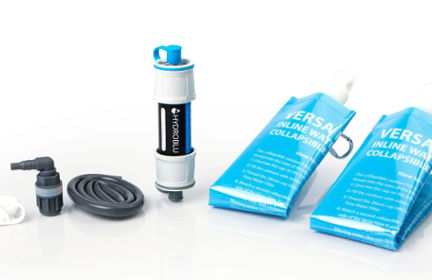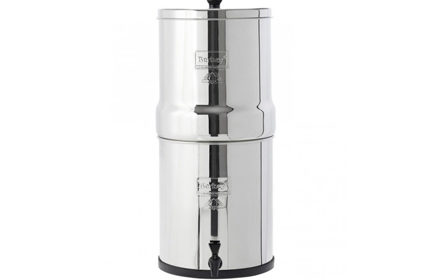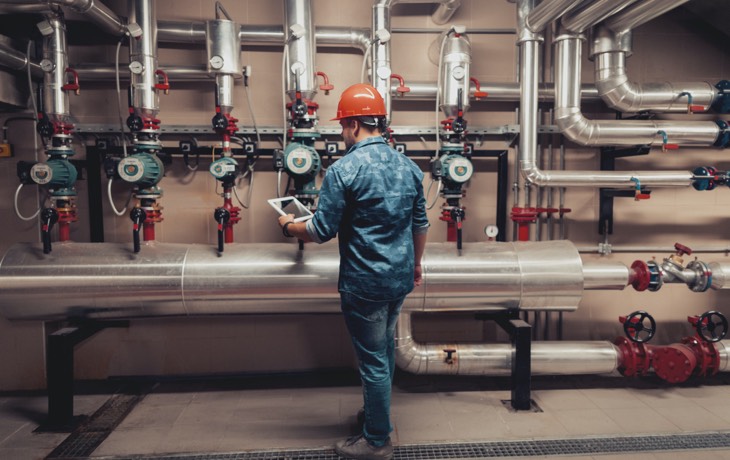Water products were one of the top items our readers purchased in the weeks before the COVID-19 lockdowns. And bottled water was one of the first things to disappear from store shelves as panic buying set in. But along with all the scenes of grocery carts full of water was a common question we saw all over the internet: “why are all these people stocking up on water for a virus?”
The short answer we gave every time was simple: Water is so important to sustaining life that you just can’t take chances with it. Making sure you’re never without stored water or the ability to treat wild water is a critical preparedness foundation.
You should:
- As outlined in our coronavirus preparedness guide, you want to store at least 15 gallons of water per person in the household, given the one gallon of water per person per day rule.
- Get a water storage container first so that you can store a few days or weeks worth of water.
- Then get a portable water filter so you can make more water inside or outside of your home.
- Finish with a larger home water filter.
It’s also possible to dive deeper into the water question, which has become increasingly important in light of recent news about COVID-19’s threat to America’s municipal water supplies. The public water supply is far more complex and fragile than people think, and just in the past fifteen years we’ve seen everything from excess rains, to cost-saving measures, to earthquakes, to a global credit crisis threaten our cities’ water systems.
There are at least three different ways COVID-19 could reveal the system’s weakest points and keep you from getting clean, drinkable water out of your tap.
Shortage of supplies used by local water companies
Take a look at this list of categories of water treatment chemicals. A shortage of any of them could hurt the water supply in many cities. We have yet to hear of any specific shortage linked to the pandemic’s disruption of global trade, but some of these chemicals are sourced abroad. If global trade slows down or stops, that would mean no potable water.
There’s a more immediate threat to the water supply, though. It comes from a sudden disruption in the supply of a critical water treatment component made right here in the US: carbon dioxide (CO2). Though it’s not called out directly in the preceding list, CO2 is an essential input for the municipal water treatment process. (It’s also vital to many critical industrial processes–from agriculture to meat processing to food preservation).
The Prepared has obtained a copy [PDF] of the Washington State emergency document that formed the basis for The Guardian’s report on the link between the CO2 shortage and the possibility of a water supply disruption.
Here are the key parts:
- Supply Chain Carbon Dioxide (CO2) – Office of Drinking Water is still responding to Friday’s notification of a national shortage of CO2. Multiple water treatment plants use this in their process of treating drinking water and current plant design depends on this. Several had received initial notification from their vendors that their supply would be restricted to 33% of normal.
- So far utilities have been able to make the case that they are considered essential to critical infrastructure and have been returned to full supply. However, we want to ask if CISA can assess this through their contacts, if this is sustainable given the national shortage.
- DOH- ODW has been connected with a regional producer in Vancouver Washington that could supply both Oxygen and CO2, should supplies run low.
- Note: There is also a similar request for information from the Association of State Drinking Water Administrators for EPA HQ…this includes status of Oxygen use for Ozone disinfection.
The Guardian’s story has even more reporting, including a link to a letter from the Compressed Gas Association warning of the CO2 shortage’s likely impact on far more than just the water supply. But the impact on clean water should be bad enough given our reliance on clean water for food processing:
Preliminary data show that production of CO2 has decreased by approximately 20%, and experts predict that CO2 production may be reduced by 50% by mid-April unless action is taken to stabilize existing sources of CO2…
CO2 is critical for the operations of food and beverage manufacturers that provide essential goods and services to Americans. CO2 is used in the processing, packaging, preservation, and shipping of many foods. In addition, CO2 in different forms is used in various aspects of the healthcare industry and is also an important component in many municipal water treatment systems…
If federal action is not swift, a slowdown in food and beverage manufacturing due to a shortage in CO2 will ultimately lead to shortages of needed goods.
The source of the disruption in CO2 is a perfect example of a cascading failure in a complex system. CO2 is an industrial byproduct of ethanol production, and since people aren’t driving their cars very much right now, ethanol demand is down. That means ethanol plants are going offline and taking much of the nation’s CO2 right along with them.
Short-term credit collapse
Unfortunately, municipal water facilities are heavily dependent on the availability of short-term credit for the purchase of chemicals, filters, and other consumable supplies used in water treatment. That’s one of the more disturbing details buried in the pages of Micheal Lewis’s The Big Short, and it’s relevant today.
When the credit markets completely seized up following the Lehman Bros bankruptcy in late 2008, Lewis reports, “The city of Chicago had only eight days of chlorine on-hand for its water supply.”
At the time, I’d been following the credit crisis via finance blogs, so I’d read that there was a danger of water treatment facilities not being able to make payroll or get critical supplies before congress acted and the markets began functioning again.
If the economic shock from the pandemic causes the credit markets to lock up like they did just over ten years ago, then we could once again be facing a threat to our water supply.
Absenteeism
If America starts to see a significant percentage of the population come down with COVID-19, then the result will be shortages of workers across the economy, as people stay home either because they’re sick or because they have to care for a sick loved one. This problem of widespread absenteeism has gotten the most attention when it comes to healthcare workers, but there are plenty of other specialized, high-skill jobs across our critical infrastructure that absolutely have to stay filled in a crisis.
This NPR report on water treatment workers gives some insight into how some workers in water treatment facilities are being asked to quarantine on-site in campers, so that they don’t risk illness and can keep the taps flowing.
KYLE DANLEY: We’re in a specialty field. There’s always a shortage of operators throughout the country, trying to get people interested in this field, but it certainly is something that takes months and years to be able to get those licenses needed. And then just even if you have a license, every plant is specific.
MASTERS: After two weeks, a new group of workers with the same set of skills, who are currently sitting at home, will switch with the current onsite crew. Something similar is happening at a desalination plant in Carlsbad, Calif., that produces 50 million gallons of water a day. Ten workers are living there for three weeks. Sandy Kerl is general manager for the San Diego County Water Authority.
SANDY KERL: These are critical services, highly trained individuals, not easily replaceable, so they have to be protected to ensure that water continues to flow.
This kind of on-site industrial quarantine is happening all over the country at many types of critical infrastructure facilities, and it’s a stark reminder of what we’re gambling with if we misjudge the virus’s threat to the public and don’t take enough precautions to keep it in check.
What you can do to ensure access to clean water
The first thing to know is that even if key treatment chemicals do run short, in most cases the taps will still flow. You’ll just need to boil your water. You should be prepared to do that in the worst case scenario. Make sure you have access to a suitable container and a safe heat source.
But boiling won’t fix everything, and it’s not always convenient or feasible. That’s why the two more important things you need for water security are:
An optional third recommendation is a home water filter that can process and store many gallons at once.

Best container for most people:
Reliance Rhino 5.5 Gal Water Container

Best filter kit for most people:
HydroBlu Versa Inline Filter Kit
Many people skip the first recommendation, the containers, because they have big plans to raid their home or apartment’s hot water heater for potable water in the event of an emergency. Don’t do that. If the public water supply is contaminated, then that contaminated water is what you’ll have in your hot water heater. It’s better to spend a few dollars on water storage than to plan on hassling with extracting the potentially undrinkable contents of a hot water heater.
The portable water filter we recommend is your next stop after a container. These inexpensive, compact filters can purify years’ worth of water for one person, and they screw right onto the end of a standard two-liter beverage container so you can use that container as a reservoir and squeeze water through the filter.
You can easily take these small filters with you if you have to bug out, so you and your family can access clean water under just about any circumstances.

Best for homes:
Big Berkey Water Filter
If you’re after more convenience than the portable filters afford, try one of the large home water filters. These big filters are far easier to use than their portable siblings, as they can hold a few gallons at a time, and some can even be refrigerated.
Ultimately, you don’t have to spend a lot of money to ensure that you and yours have uninterrupted access to safe, drinkable water no matter what COVID-19 throws at our critical infrastructure. So if this is a prep you’ve been ignoring because, hey, it’s just a virus, then right now is the time to correct that oversight.



You are reporting the comment """ by on